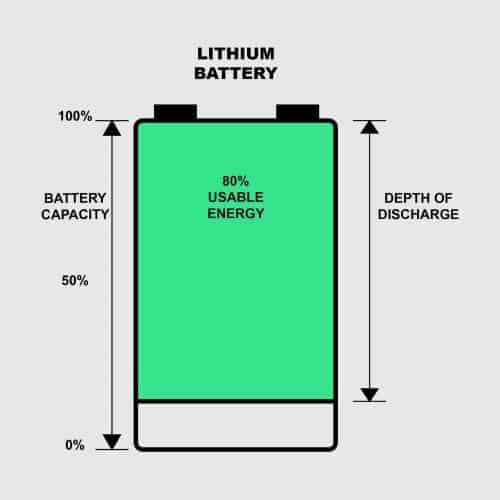Solar batteries are a critical component of a solar energy system as they store energy generated during the day for use at night or during a power outage.
However, solar batteries are a significant investment, and extending their lifespan is crucial for maximising both cost savings and system efficiency. In this article, we provide practical tips on how to prolong the life of your solar batteries, ensuring your investment continues to pay off for years.
Table of Contents
What Affects Solar Battery Lifespan?
The lifespan of a solar battery refers to how long it can effectively store and supply energy before its capacity degrades. Several factors influence this lifespan:
- Battery Cycles: A battery cycle occurs each time a battery is charged and then discharged. The more cycles a battery undergoes, the closer it gets to the end of its lifespan. Lithium-ion batteries for example typically last between 2,000 to 5,000 cycles, depending on usage and maintenance.
- Capacity Degradation: Over time, a battery’s ability to hold a charge decreases, a process known as capacity degradation. This is a natural occurrence but can be accelerated by poor maintenance practices.
- Environmental Factors: Extreme temperatures, high humidity, and exposure to dust can all shorten the lifespan of a solar battery. Batteries kept in a cool, dry place tend to last longer.
Regular maintenance and monitoring are essential for extending the life of your solar battery. Different types of solar batteries—such as lead-acid and lithium-ion—have varying lifespans. Lead-acid batteries generally last about 3 to 5 years, while lithium-ion batteries can last up to 10 years with proper care.
Best Practices for Maintaining Solar Batteries
Regular Cleaning and Inspection
One of the simplest yet most effective ways to extend the lifespan of your solar battery is through regular cleaning and inspection. Dust and debris can accumulate on your battery, leading to poor performance and potential damage.
- Cleaning: Use a dry cloth to gently wipe the battery case, removing dust and dirt. Avoid using water or cleaning agents that could cause corrosion.
- Inspection: Check for visible signs of wear, such as cracks or leaks. Also, inspect the battery terminals for corrosion, which can be cleaned using a mixture of baking soda and water.
Proper Charging Practices
Proper charging is vital for maintaining solar battery lifespan. Overcharging or allowing your battery to discharge too deeply can significantly reduce its lifespan.
- Avoid Deep Discharges: Try to keep your battery’s state of charge above 20% for lithium and 50% for lead-acid. Deep discharges can strain the battery and reduce its overall capacity.
- Use Charge Controllers: A charge controller is a device that regulates the voltage and current flowing to the battery, preventing overcharging and extending the battery’s life. Smart chargers, which adjust charging based on the battery’s needs, are also beneficial.

Temperature Management
Temperature has a significant impact on solar battery lifespan. Batteries stored in extremely hot or cold environments degrade quickly.
- Cool, Dry Storage: Keep your batteries in a location where the temperature is stable, ideally between 15°C and 25°C. High temperatures can cause batteries to overheat, while very low temperatures can reduce their capacity.
- Temperature Sensors: Some battery monitoring systems include temperature sensors that alert you if the battery is operating outside its optimal temperature range.
Equalisation Charging
Equalisation charging is a controlled overcharge applied to flooded lead-acid batteries to balance the charge between cells, reduce sulfation, and prolong battery life.
- Frequency: For lead-acid batteries, equalisation charging should be performed every month or two. Lithium-ion batteries do not require this process.
- Procedure: Follow the manufacturer’s guidelines for equalisation charging, as improper use can cause damage.
Solar Battery Monitoring and Health Checks
Using Battery Monitoring Systems
Battery monitoring systems (BMS) provide real-time data on your battery’s performance, including charge levels, voltage, temperature, and health status. This data helps you make informed decisions about maintenance and usage.
Use a multimeter to check the voltage of your battery. A significant drop in voltage can be a sign that your battery is nearing the end of its life.
Professional Maintenance Services
While regular DIY maintenance is important, periodic professional maintenance can help ensure that your battery system remains in top condition.
A professional technician will perform a thorough inspection, including checking connections, testing battery capacity, and ensuring that all components are functioning correctly.
Regular professional maintenance can help prevent costly repairs or replacements down the line, ultimately extending the life of your solar battery.
Troubleshooting Common Solar Battery Issues
Common issues with solar batteries include sulfation (the buildup of lead sulphate crystals in lead-acid batteries), capacity loss, and voltage drops.
For lead-acid batteries, sulfation can sometimes be reversed with equalisation charging. However, if the issue persists, the battery may need to be replaced.
If your battery is losing capacity, try to identify the cause by checking for improper charging, extreme temperatures, or ageing.
When to Replace Your Solar Battery
Knowing when to replace your solar battery is crucial for maintaining system efficiency. If your battery can no longer hold a charge, or if voltage drops significantly even after a full charge, it may be time for a replacement.
Choose a battery that matches your system’s requirements and consider factors like lifespan, cost, and maintenance needs.
Conclusion
Extending your solar battery lifespan helps you get the most out of your investment. By following the tips and best practices discussed in this article—regular cleaning and inspection, proper charging, temperature management, and health checks—you can ensure your battery continues to perform efficiently for longer.
For comprehensive solar battery care, consider professional maintenance services to catch potential issues early and keep your system running smoothly.
Contact us via our Facebook page or WhatsApp number to get professional maintenance services or purchase battery monitoring systems. Keep your solar energy system running at its best and extend the life of your solar battery today!